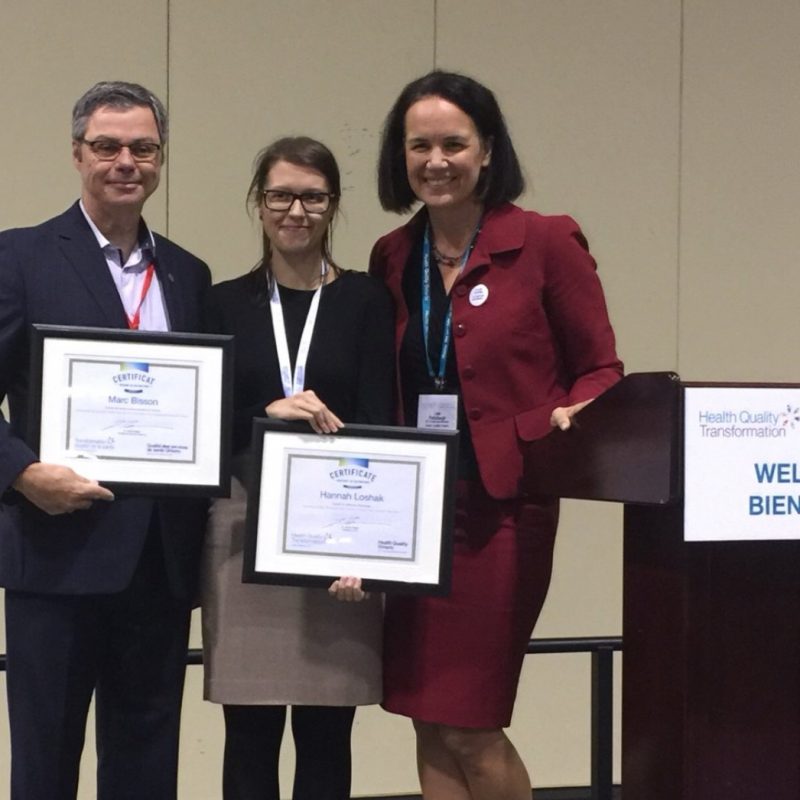CSCE Low Back Pain Pilot Project Takes Top Honors at Health Quality Ontario Conference

Marc Bisson, Executive Director at the Centre de santé communautaire de l’Estrie (CSCE) received a distinction award after delivering a brief presentation on the quality of care received under the low back pain pilot project during Health Quality Ontario’s conference which was held in Toronto on October 24, 2017.
Under the theme Quality Matters, this conference focused on bringing quality care to the Ontario health care system and the best way to achieve this goal. More than 300 abstracts, which focused on six dimensions of a high-functioning health system, were received and reviewed by a panel consisting of members from Health Quality Ontario, partner organizations and patient advisors from across Ontario. The low back pain pilot project ranked at the top of its category. The following six dimensions were taken into consideration during the reviewal process: safety, effectiveness, patient-centredness, efficiency, timeliness and equity.
The low back pain pilot project began at the CSCE in January 2015. It is designed to help interprofessional health care teams provide the best possible care to patients suffering from low back pain. By hiring two chiropractors, the CSCE has increased access to care, resulting in the treatment of patients who otherwise would not have received such services. Generally, the treatment of low back pain by a chiropractor can cost upwards of $400, which means individuals with low incomes or those who do not have insurance are unlikely to access these services. Moreover, this project helps lower costs by reducing the number of unnecessary diagnostic imaging tests like X-rays, computed tomography (CT) scans and magnetic resonance imaging (MRI) scans.
Since the inception of the pilot project, more than 470 patients have seen a chiropractor at the CSCE or at the Glengarry Nurse Practitioner-Led Clinic in Lancaster, where the CSCE also offers English services. Chiropractic treatment consists of a rigorous examination to assess if the problem is muscle or joint-related, or if it is the result of another health problem. This is followed up with adjustments to the spine, muscles and surrounding structures. Lastly, treatment includes teaching patients how to better manage their pain by doing exercises and following certain recommendations so they can heal faster. On average, ten visits are required for treatment.
The project has achieved many positive outcomes. From a patient perspective, many have reduced the dose of their pain medication. Recreational activities previously abandoned due to low back pain were also resumed more quickly after treatment.
Below are some interesting facts gathered from a survey conducted on 146 patients who received services through the low-back pain pilot project:
- 94% were satisfied or extremely satisfied with the assessment of their condition and the services rendered.
- 87% agreed or strongly agreed that the pilot project enabled them to receive services they may not have otherwise received.
- 83% agreed or strongly agreed that they required less medication to help manage their low back pain after receiving services.
- 91% agreed or strongly agreed that they were better able to self-manage their low back pain after receiving services.
- 93% agreed or strongly agreed that their quality of life had improved after receiving services.
The pilot project has also generated positive impacts on the health care system, including:
- A reduction in referral consultations with specialists and diagnostic imaging tests.
- A reduction in hospital emergency visits for low back pain problems.
- A reduction in medication being prescribed for low back pain.
Initially, the Ministry of Health and Long-Term Care funded the pilot project for two years, from 2015 to 2017. However, given its overall positive outcomes, financing has been extended until 2018, after which time we cannot say with certainty if the project will continue. “This pilot project quickly exceeded expectations. The formula is simple, effective and cost-efficient. It would be a shame for it to come to an end in March 2018 due to a lack of funding. The outstanding work of our team of chiropractors not only significantly reduces the costs on the health care system but changes the lives of individuals who suffer from low back pain.” added Marc Bisson, Executive Director at the CSCE.
For more details on the CSCE low back pain pilot project, click here.